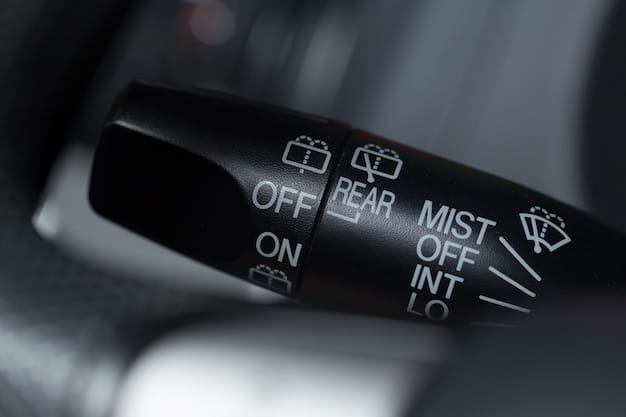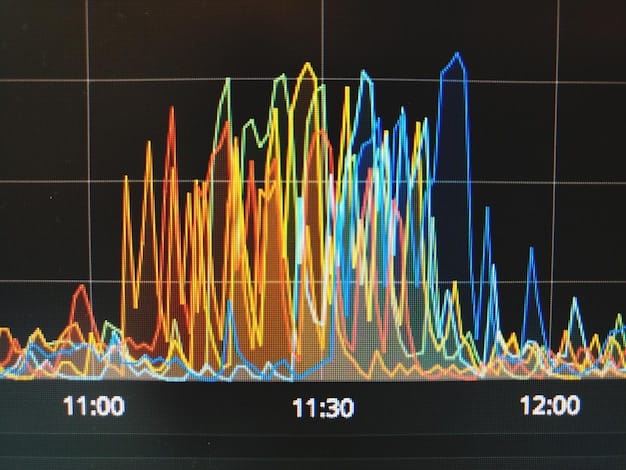2025 Car Buying: MSRP vs. Invoice Price vs. Market Value Explained

Understanding the differences between MSRP (Manufacturer’s Suggested Retail Price), invoice price, and market value is crucial for making informed decisions when buying a car in 2025, ensuring you negotiate the best possible deal.
Navigating the car buying process can feel like deciphering a secret code, especially when trying to understand pricing. Let’s break down the key differences between MSRP, invoice price, and market value in 2025 car buying, empowering you to drive away with confidence.
Understanding the Manufacturer’s Suggested Retail Price (MSRP)
The MSRP, or Manufacturer’s Suggested Retail Price, is the price a car manufacturer recommends a dealership sell a vehicle for. It’s often referred to as the “sticker price” because it’s displayed on a sticker on the car’s window. However, it’s important to remember that the MSRP is just a suggestion, not a fixed price.
Think of the MSRP as the starting point for negotiations. While dealerships might try to sell a car at MSRP, there’s often room to negotiate the price down, particularly if you’re a savvy negotiator and understand the other factors that influence car prices.
What’s Included in the MSRP?
The MSRP typically includes the base price of the vehicle, any standard equipment, manufacturer-installed options, and the destination charge (the cost of transporting the vehicle from the factory to the dealership). It doesn’t include state and local taxes, title, license, or dealer-installed options.
Why is MSRP Important?
Understanding the MSRP provides a benchmark for comparing prices across different dealerships and models. It also gives you a starting point for negotiations. While you shouldn’t necessarily aim to pay MSRP, knowing this number helps you gauge the potential savings you can achieve.
Keep in mind that the MSRP can fluctuate based on various factors, including supply and demand, model popularity, and any incentives or rebates offered by the manufacturer. It’s always a good idea to research the MSRP of the specific vehicle you’re interested in before heading to the dealership.

In conclusion, the MSRP is a valuable piece of information for any car buyer. It serves as a reference point and helps you understand the base cost of the vehicle before adding any additional fees or negotiating a final price.
Decoding the Invoice Price
The invoice price is what the dealership pays the manufacturer for the vehicle. It’s often seen as the “true” cost of the car, but even this figure can be misleading due to holdbacks, incentives, and other factors. Understanding the invoice price gives you a better idea of the dealer’s cost and how much room they have to negotiate.
While dealerships are unlikely to sell a car for less than the invoice price (they need to make a profit, after all), knowing this number can help you negotiate a price that’s fair for both you and the dealer.
- Finding the Invoice Price: Websites like Kelley Blue Book and Edmunds often provide estimates of the invoice price for different vehicles.
- Understanding Dealer Incentives: Keep in mind that dealerships often receive incentives from manufacturers based on sales volume or specific models sold. These incentives can further reduce the dealer’s actual cost.
- Importance of Negotiation: Don’t be afraid to negotiate aggressively, especially if you know the invoice price and any potential dealer incentives.
The invoice price typically includes the base price of the vehicle, any factory-installed options, and the destination charge. It doesn’t include advertising fees, dealer markups, or other fees added by the dealership.
It’s also worth noting that the invoice price can vary slightly depending on the region and the specific dealership. Some dealerships may also receive additional discounts or incentives based on their relationship with the manufacturer.
Ultimately, understanding the invoice price is another valuable tool in your car buying arsenal. It helps you understand the dealer’s perspective and negotiate a price that’s fair for everyone involved.
Understanding Market Value in 2025
Market value refers to the price a car is actually selling for in a specific market. This value can differ significantly from both the MSRP and the invoice price due to factors like supply and demand, regional variations, and current incentives.
In 2025, understanding market value is more important than ever due to fluctuating inventory levels and changing consumer preferences. Factors like fuel efficiency, technology features, and overall vehicle condition all play a role in determining market value.
Factors Affecting Market Value
Several factors can influence the market value of a car, including:
- Supply and Demand: If a particular model is in high demand but short supply, its market value will likely be higher.
- Regional Variations: Market value can vary depending on the region due to differences in local economies and consumer preferences.
- Incentives and Rebates: Manufacturer incentives and rebates can significantly impact the market value of a car by lowering its effective price.
To determine the market value of a car, research recent sales of similar vehicles in your area. Websites like Kelley Blue Book, Edmunds, and TrueCar can provide valuable data on market trends and pricing.
Understanding market value also helps you time your purchase effectively. If you’re looking to buy a car that’s currently in high demand, you might want to wait until supply levels increase to get a better deal.
In conclusion, keeping a close eye on market trends is essential for making informed decisions in 2025 car buying. By understanding market value, you can avoid overpaying and ensure you’re getting a fair price for your new vehicle.

Negotiation Strategies for 2025 Car Buying
Effective negotiation is key to getting the best possible deal on your new car in 2025. Armed with an understanding of MSRP, invoice price, and market value, you can approach negotiations with confidence and increase your chances of saving money.
Remember, negotiation is a two-way street. Be prepared to walk away if the dealer isn’t willing to meet your needs. Having a clear understanding of your budget and the value of the vehicle you’re interested in will help you stay firm during negotiations.
Tips for Successful Negotiation
- Do Your Research: Before heading to the dealership, research the MSRP, invoice price, and market value of the vehicles you’re interested in.
- Shop Around: Get quotes from multiple dealerships to compare prices and negotiate the best deal.
- Be Prepared to Walk Away: Don’t be afraid to walk away if the dealer isn’t willing to meet your needs.
- Negotiate the Out-the-Door Price: Focus on the final price, including all fees and taxes, rather than getting bogged down in monthly payments.
It’s also important to be polite and professional during negotiations. Building a rapport with the salesperson can often lead to a more favorable outcome.
Another effective strategy is to negotiate at the end of the month or quarter, when dealerships are often eager to meet sales quotas and may be more willing to offer discounts.
In conclusion, effective negotiation is a crucial skill for any car buyer. By following these tips and being prepared to walk away, you can increase your chances of getting a great deal on your new car in 2025.
The Impact of Incentives and Rebates
Incentives and rebates can significantly impact the final price you pay for a car. Understanding the different types of incentives and how to qualify for them can save you thousands of dollars.
In 2025, manufacturers and dealerships are increasingly offering incentives to promote sales of electric vehicles and other fuel-efficient models. Taking advantage of these incentives can make owning a greener car more affordable.
Types of Incentives and Rebates
There are various types of incentives and rebates available to car buyers, including:
- Manufacturer Rebates: These are discounts offered directly by the manufacturer, often available to all buyers.
- Dealer Incentives: These are incentives offered by the dealership, which they may or may not pass on to the buyer.
- Government Incentives: These are rebates or tax credits offered by federal, state, or local governments to encourage the purchase of electric vehicles or other fuel-efficient models.
To find out about available incentives and rebates, check the manufacturer’s website, the dealership’s website, and government resources like the IRS website.
Be sure to read the fine print and understand the eligibility requirements for each incentive. Some incentives may only be available to certain buyers, such as those who finance through the manufacturer or meet certain income requirements.
In conclusion, incentives and rebates can play a significant role in lowering the overall cost of your car. By researching available incentives and understanding the eligibility requirements, you can maximize your savings and drive away with a great deal.
Financing and Leasing Options in 2025
Financing and leasing are two common ways to acquire a car. Understanding the differences between these options and their respective advantages and disadvantages is crucial for making the right choice for your financial situation.
In 2025, interest rates and leasing terms can fluctuate significantly, making it even more important to compare offers from different lenders and dealerships. Factors like your credit score and the type of vehicle you’re interested in can affect your financing and leasing options.
Financing vs. Leasing
Here’s a quick overview of the key differences between financing and leasing:
- Financing: You borrow money to purchase the car outright. You make monthly payments until the loan is paid off, and you own the car at the end of the loan term.
- Leasing: You essentially rent the car for a set period of time, typically two to three years. You make monthly payments, and at the end of the lease term, you return the car to the dealership.
Financing is generally a better option if you plan to keep the car for a long time and want to build equity. Leasing can be a good choice if you want to drive a new car every few years and don’t want to worry about maintenance or resale value.
Before making a decision, consider your budget, driving habits, and long-term financial goals. It’s also a good idea to get pre-approved for financing from your bank or credit union to get a better idea of the interest rates and terms you qualify for.
In conclusion, understanding the differences between financing and leasing is essential for making an informed decision. Consider your individual needs and circumstances when choosing the best option for acquiring your new car in 2025.
| Key Point | Brief Description |
|---|---|
| 💰 MSRP | Manufacturer’s Suggested Retail Price; starting point for negotiation. |
| 🧾 Invoice Price | What the dealer pays the manufacturer; reveals dealer cost. |
| 📈 Market Value | The actual selling price, influenced by supply and demand. |
| 🤝 Negotiation | Essential for securing the best deal; research and compare prices. |
FAQ
▼
MSRP is the manufacturer’s suggested retail price, while the invoice price is what the dealership pays the manufacturer. The difference represents the dealer’s potential profit margin before incentives.
▼
Market value reflects the current demand and availability of a vehicle. High demand can drive prices above MSRP, while low demand might lead to discounts below invoice price.
▼
It’s possible, but challenging. Dealers have incentives from manufacturers that can reduce their costs, allowing some room. Research and skilled negotiation are key.
▼
Look for manufacturer rebates, dealer incentives, and government incentives, especially for electric vehicles. Check eligibility requirements to maximize your savings.
▼
Financing is better for long-term ownership and building equity. Leasing is suitable for driving new cars regularly without long-term commitments or maintenance concerns.
Conclusion
Understanding the intricacies of MSRP, invoice price, and market value is paramount for making informed car buying decisions in 2025. By combining this knowledge with effective negotiation strategies and awareness of available incentives, you can confidently navigate the car buying process and secure the best possible deal.





